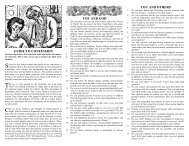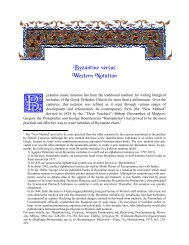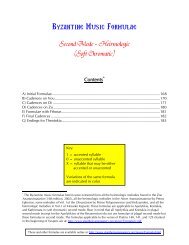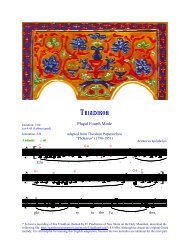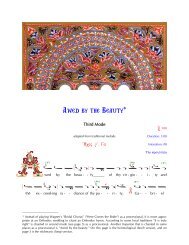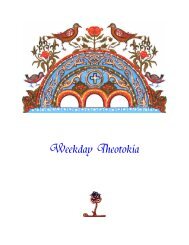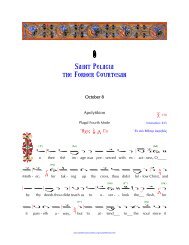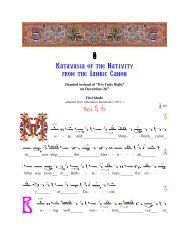Reading Psalmodia (PDF) - St. Anthony's Monastery
Reading Psalmodia (PDF) - St. Anthony's Monastery
Reading Psalmodia (PDF) - St. Anthony's Monastery
You also want an ePaper? Increase the reach of your titles
YUMPU automatically turns print PDFs into web optimized ePapers that Google loves.
16. TRANSCRIBING PSALMODIA into EUROPEAN NOTATIONPsaltic notation is a completely different kind of notation from the European staffnotation. The basis of the staff notation is its ability to show the pitch and duration of thenotes to be played or sung: psaltic notation shows the duration of notes, but unlike thestaff notation it shows not the pitch of a specific note, but the interval between that noteand the note preceding it. Moreover, the nature of the staff notation means that themusical text works as a sort of diagram of the melody; the rise and fall in pitch isrepresented by the place the notes of the melody occupy on the staff. In psaltic notation,all the musical signs lie on or about a straight line, so that the musical text has no realdiagrammatic function. Transcribing music from the one notation to the other involvesrepresenting the melody in a quite different way from that in which it is represented inthe original text.The staff system uses the semitone as its smallest interval, whereas psaltic music usesmicrotonal intervals. In general, music written in staff notation is interpreted in terms ofthe equal temperament system of intervals that corresponds to the tuning of Tone III;there is no obvious way of representing the intervals of the true Diatonic and the twoChromatic scales used in <strong>Psalmodia</strong>.Grave as these problems may seem at first sight, they are not insuperable. It is worthrecalling that the exact intervals intended by the signs of the psaltic notation is onlydeterminable if we know the Tone in which a piece is to be sung. The same sequence ofsigns represents a quite different sequence of intervals in pieces written in differentTones. This suggests at least one way of solving the principal problem of transcription: ifthe Tone of a piece is identified, then the staff notation can be re-interpreted to intendthe intervals used in the scales of the specific mode in use. There is, unfortunately, aserious disadvantage to this solution: an inexpert musician attempting to read a piece of<strong>Psalmodia</strong> transcribed into staff notation will be misled as to the actual intervalsintended by the musical text unless she or he knows the tuning of the Tone in use.Most existing transcriptions intended for use by singers simply transcribe the notes ofthe melody representing microtonal intervals as semitones and leaving it to the singer’sknowledge of the Tones to suggest a more exact interpretation. When, as, for example, inthe set of ‘bilingual’ versions of the liturgical hymns published by Kapsaskes, psaltic andstaff notations face each other on opposite pages of the book, there is no grave danger ofmisunderstanding: if the staff notation alone is presented, then misunderstanding is alltoo probable.The easiest way to enable accurate transcription of psaltic melodies into staff notation isto add a few new accidentals to the staff system. It has already been argued above thatin practice <strong>Psalmodia</strong> uses three degrees of flat and three degrees of sharp. If we retainthe normal flat and sharp of the staff system to represent the middle degree of flatness orsharpness, then we require signs to represent the flattish, the sharpish, the very flat andthe very sharp. Two of these already lie at hand: in the equal temperament system adouble-flat flattens a note by a whole tone, a double-sharp sharpens it by a whole tone.Psaltic music does not require double-sharp or double-flat signs for such a purpose,leaving them available for use to represent the very-flat and the very-sharp of psaltic





